Native to the tropical climates of the Americas and West Indies, custard apples are a tropical treat with sweet, creamy flesh. Typically grown in high-altitude areas, we’re lucky enough to have them grown locally on the Sunshine Coast. At Yanalla Farms in the beautiful Glass House Mountains hinterlands, they’re not growing any ordinary custard apples—they’re exclusive plant breeders, owners and producers of the PinkBlush variety. Yanalla Farms managing director Karen Martin tells us more about this blushing beauty.
Tell us a little bit about Yanalla Farms:
Yanalla Farms is a family business, owned and managed by second-generation farmers Robert and Karen Martin. Their 55-acre ‘office’ is nestled in the beautiful hinterland area of Glass House Mountains, in one of Australia’s largest regional economies, the Sunshine Coast.
Yanalla Farms is a tropical fruit treasure trove, specialising in lychees, dragon fruit and custard apples. The Martins’ future focus is expanding their custard apple orchard to about 5,000 trees.
For the uninitiated, what is a custard apple?
Custard apples are a decorative and unusual fruit with white, creamy flesh and shiny black seeds. Unlike the name suggests, the flesh of a custard apple is not crunchy like an apple but has a texture similar to kiwi fruit.
Originally native to South America, Australian custard apples are a unique hybrid of the sugar apple and cherimoya. Australian custard apples are generally harvested from February to September and are typically green in colour.
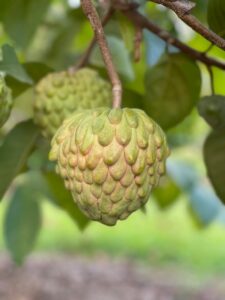
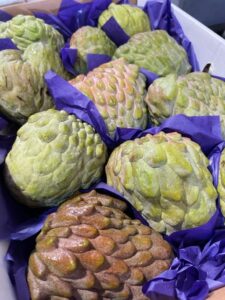
Tell us how the PinksBlush variety came about:
By pure serendipity, a new custard apple variety is transforming this innovative and progressive family business that offers something special to the world.
Over 20 years ago on one fine September day, Robert’s father discovered some fruit ripening on a single branch of an existing Pinks Mammoth variety of custard apple tree.
This variety started life as a ‘bud sport’, which is the part of the plant that displays morphological differences from the rest of the plant, often considered to be chance genetic mutations.
A truly surprising feature was the unique appearance of the fruit. The raised dimples on the ripening fruit developed a rich tapestry of pastel pinkish-orange colours that resembled a blush.
And so, after the Martins’ secured plant breeder rights, the name PinksBlush was born. This fruit is really in a class of its own and the only Australian custard apple in season from September to December. PinksBlush is not grown anywhere else around the world, only at Yanalla Farms.
Yanalla Farms is uniquely placed to exponentially grow, given the PinksBlush variety will be released to commercial growers in the coming years through a royalties-based business model.
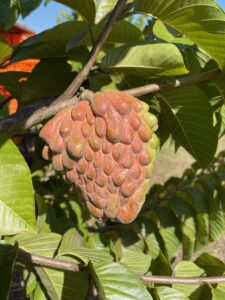
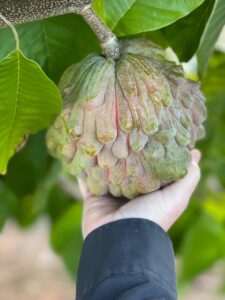
What do they taste like?
Custard apples have a unique, sweet flavour and the flesh is soft and creamy. Black seeds are dotted among the flesh, but these are discarded.
How much do you produce each year?
Our custard apple orchards are still maturing, so the quantity of fruit being produced now is limited. When trees reach full maturity in a few years’ time, we expect to produce around 50-to-60kgs per tree.
Where does your produce go?
Our lychees, dragon fruit and custard apples are predominantly sold to Melbourne Wholesale Markets. To cater for the increasing Australian consumer demand for the PinksBlush variety, we anticipate selling fruit to other interstate markets, as well as eventually exporting the fruit. To satisfy our local market, we sell seasonal farm gate produce through the e-commerce platform on our website, offering full-tray or half-tray quantities.
What are the biggest challenges of growing custard apples?
The demands of managing pest and disease pressure are constant. The biggest challenges we face with growing custard apples is dealing with Mother Nature. About two years ago, we weathered three ferocious hailstorms over a 15-month period on our property. Our custard apples harvest had only just started. When hail struck, the event only last 10 minutes but damage was extensive. Leaves and bark were stripped off the trees and every piece of fruit sustained hail marks, but only on the southern facing side, as that’s where the hail came from. No fruit was salvageable and even today, our trees still bear the scars.
When do you harvest? Is it a very labour-intensive process?
Our custard apple season is from September to December. Custard apples have a very delicate skin, so the fruit must be handled with care, making harvest a very labour-intensive process. Fruit is hand-picked using secateurs, placed in a foam lined crate to prevent skin rub, then transported back to the cold rooms as quickly as possible. Each piece of fruit is inspected before packing into individual foam mesh ‘socks’.
What is the best way to eat a custard apple?
A custard apple is usually firm to touch when bought. To speed up the ripening process, place the custard apple in a paper bag with a banana, or leave the fruit on the kitchen bench to ripen naturally. This usually take a couple of days, but as the fruit ripens, it will give slightly under pressure when squeezed, like an avocado. Place back in the fridge to cool down. When ready to eat, simply break in half with your hands and use a spoon to scoop out the flesh. Remember not to swallow the seeds.


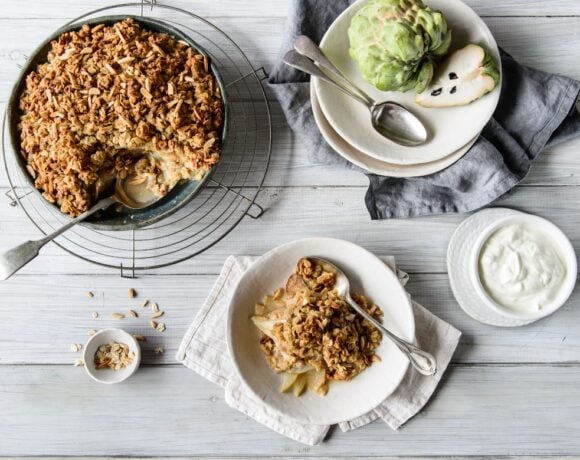


COMMENTS